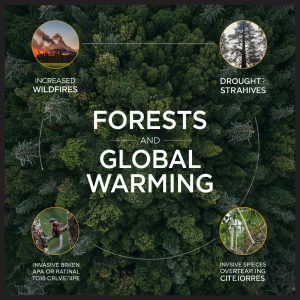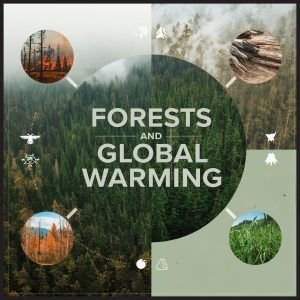Forests and Global Warming
Forests and Global Warming are intricately linked, as forests act as vital carbon sinks, absorbing carbon dioxide and mitigating climate change. The destruction of forests through deforestation, logging, and land-use change contributes significantly to global warming, releasing stored carbon into the atmosphere and disrupting ecosystems. Protecting and restoring forests is therefore a crucial component of global strategies to combat climate change, preserve biodiversity, and ensure ecological balance.

Forests cover nearly 31% of the Earth’s land area, providing habitat for millions of species, regulating water cycles, and influencing climate patterns. By absorbing atmospheric carbon and releasing oxygen, forests help regulate global temperatures and maintain air quality. The relationship between Forests and Global Warming highlights the urgency of sustainable forest management and conservation practices worldwide.
The Role of Forests in Climate Regulation
Forests play a pivotal role in stabilizing the Earth’s climate. Through the process of photosynthesis, trees absorb carbon dioxide, a major greenhouse gas, and store it in their biomass. This natural carbon sequestration reduces the concentration of greenhouse gases in the atmosphere, mitigating the effects of global warming.
Tropical rainforests, such as the Amazon, act as massive carbon reservoirs. Temperate and boreal forests also contribute to carbon storage, although at varying rates depending on species composition and growth conditions. Forests influence local and global climates by moderating temperatures, regulating precipitation patterns, and maintaining humidity levels. Understanding the interplay between Forests and Global Warming is essential for designing effective climate policies and environmental strategies.
Deforestation and Carbon Emissions
One of the primary drivers of global warming is deforestation. Clearing forests for agriculture, urbanization, or logging releases vast amounts of stored carbon into the atmosphere, exacerbating climate change. Forests and Global Warming are therefore deeply affected by human activity, as deforestation accounts for nearly 10% of global greenhouse gas emissions.
Slash-and-burn techniques, illegal logging, and forest degradation further intensify carbon release and reduce the Earth’s capacity to absorb CO₂. Habitat loss threatens wildlife, reduces biodiversity, and destabilizes ecosystems. Implementing sustainable forest management, reforestation, and agroforestry practices can significantly reduce emissions and restore ecological balance, forming key strategies to address the link between Forests and Global Warming.
Reforestation and Afforestation Strategies
Reforestation and afforestation are powerful tools to combat global warming. Forests and Global Warming can be mitigated by planting trees in deforested areas (reforestation) or establishing new forests in previously non-forested lands (afforestation). These efforts increase carbon sequestration, enhance biodiversity, and restore ecosystem services.
Choosing native species for reforestation ensures resilience, ecological compatibility, and long-term sustainability. Mixed-species plantations provide greater carbon storage, support wildlife habitats, and reduce vulnerability to pests and diseases. Community involvement in tree planting initiatives fosters environmental stewardship and social responsibility. By prioritizing reforestation and afforestation, societies can leverage natural systems to counteract global warming.
Forest Conservation and Sustainable Management
Conserving existing forests is critical in reducing greenhouse gas emissions. Forests and Global Warming benefit from sustainable management practices that maintain forest cover, prevent illegal logging, and promote selective harvesting. Community-based forest management empowers local populations to protect forests while generating sustainable livelihoods.
Protected areas, national parks, and wildlife reserves prevent deforestation and habitat fragmentation, ensuring the long-term health of forest ecosystems. Certification programs, such as FSC (Forest Stewardship Council), promote responsible forestry practices and market accountability. Integrating conservation, restoration, and sustainable management is essential for addressing the complex relationship between Forests and Global Warming.
Forests and Biodiversity Conservation
Healthy forests support extraordinary biodiversity, from microorganisms and plants to mammals and birds. Forests and Global Warming are interdependent because climate change can disrupt species distribution, while biodiversity loss can reduce the resilience of forests to environmental stress.
Biodiverse forests are better at carbon sequestration, pest control, and nutrient cycling. Protecting endangered species, maintaining habitat corridors, and promoting ecological restoration are vital components of sustainable forest management. By valuing biodiversity alongside carbon storage, policymakers and conservationists enhance the effectiveness of Forests and Global Warming mitigation strategies.
Forests and Soil Protection
Forests protect soil from erosion, maintain fertility, and regulate hydrological cycles. The removal of trees exposes soil to wind and water erosion, leading to nutrient loss and degraded landscapes. Forests and Global Warming are interconnected, as healthy soils store carbon and support forest growth.
Agroforestry systems, combining crops and trees, enhance soil structure, prevent erosion, and increase carbon sequestration. Mulching, cover cropping, and reduced tillage techniques complement forest conservation efforts. Protecting soil through forests and sustainable land management strengthens the global response to climate change.

Forests in Urban and Suburban Landscapes
Urban forestry and tree planting initiatives contribute to mitigating the effects of Forests and Global Warming. Green belts, street trees, and rooftop gardens reduce urban heat islands, filter air pollutants, and provide shade. Trees in cities absorb CO₂, regulate temperatures, and improve the quality of life.
Integrating forests into urban planning promotes environmental sustainability and enhances resilience to climate impacts. Parks, community gardens, and green corridors foster social engagement and biodiversity. Urban forests demonstrate that even small-scale tree planting can contribute to broader forest and Global Warming mitigation efforts.
Policy Frameworks and International Collaboration
Global agreements and national policies are essential to protect forests and combat climate change. Forests and Global Warming require international cooperation, such as the REDD+ program (Reducing Emissions from Deforestation and Forest Degradation), which provides financial incentives to developing countries for forest conservation.
Legislation, land-use planning, and enforcement mechanisms support forest protection and sustainable management. International collaborations facilitate knowledge sharing, funding, and capacity building. Policy alignment at local, national, and global levels ensures that forests contribute effectively to mitigating forest and Global Warming.
Climate Adaptation and Resilience
Forests are vulnerable to climate change impacts, including wildfires, pest outbreaks, and extreme weather events. Building resilient forests is crucial in addressing Forests and Global Warming. Adaptive management strategies, such as controlled burns, pest monitoring, and selective thinning, enhance forest resilience and reduce vulnerability.
Climate-resilient forests maintain carbon storage capacity, protect biodiversity, and support ecosystem services under changing environmental conditions. Investing in adaptation ensures that forests continue to serve as essential buffers against global warming, benefiting both nature and human communities.
Education, Awareness, and Community Engagement
Raising awareness about the importance of forests in combating global warming is essential. Forests and Global Warming are better protected when communities understand their ecological, social, and economic value. Educational programs, campaigns, and participatory initiatives empower citizens to take action.
Tree planting drives, workshops, and environmental clubs engage individuals in sustainable practices. Schools and universities can integrate forest conservation into curricula to foster long-term stewardship. By promoting knowledge and participation, society strengthens the link between Forests and Global Warming mitigation efforts.
Technological Innovations in Forest Conservation
Technology enhances forest monitoring, management, and restoration. Forests and Global Warming benefit from satellite imagery, drones, and GIS mapping, which track deforestation, forest health, and carbon stocks. Predictive analytics and AI models support sustainable management and policy decisions.
Remote sensing allows for early detection of illegal logging, forest fires, and pest outbreaks. Automated monitoring and data-driven interventions improve efficiency, accuracy, and impact in protecting forests. Technological integration reinforces the effectiveness of Forests and Global Warming mitigation initiatives.
The Economic Value of Forests
Forests provide economic benefits that complement their environmental role. Forests and Global Warming are linked through ecosystem services that support agriculture, water resources, tourism, and non-timber forest products. Valuing forests economically incentivizes conservation and sustainable management.
Payments for ecosystem services, carbon credits, and sustainable forestry enterprises create financial motivation to maintain forest cover. By recognizing both ecological and economic benefits, societies can promote long-term protection of forests, enhancing strategies to combat Forests and Global Warming.
International Case Studies and Success Stories
Several countries demonstrate successful approaches to managing Forests and Global Warming. Costa Rica, for example, has reversed deforestation trends through strong policy frameworks, reforestation initiatives, and payments for ecosystem services. Brazil’s Amazon rainforest programs aim to reduce illegal logging while promoting sustainable livelihoods.
Community forestry in Nepal and agroforestry in Africa highlight local-level solutions that balance human needs with environmental conservation. These examples show that effective forest management, backed by policy, community involvement, and innovation, can mitigate the impacts of Forests and Global Warming.
Conclusion
In conclusion, Forests and Global Warming are inseparable, as healthy forests act as essential carbon sinks, protect biodiversity, and support human well-being. Deforestation, forest degradation, and climate change threaten these critical ecosystems, emphasizing the urgency of conservation, restoration, and sustainable management.

Through reforestation, afforestation, urban forestry, policy enforcement, technological innovation, and community engagement, forests can continue to mitigate global warming effectively. Protecting forests is not only an environmental necessity but also a social, economic, and ethical imperative. Embracing strategies that safeguard Forests and Global Warming ensures a resilient, balanced, and sustainable future for generations to come.
